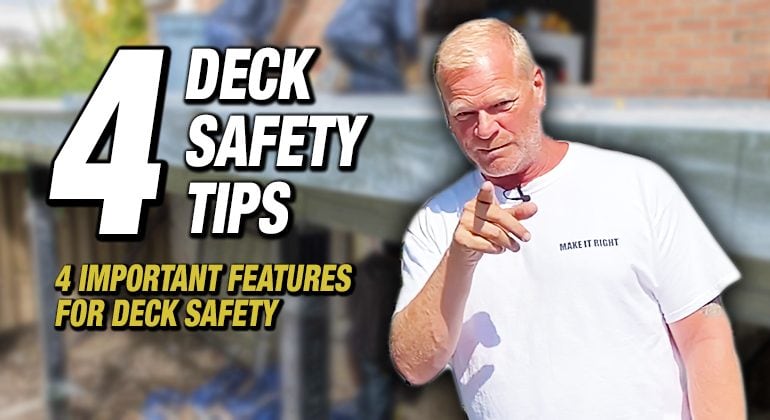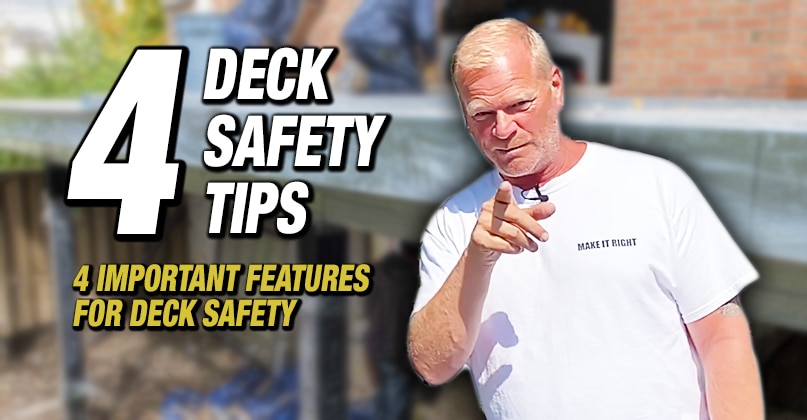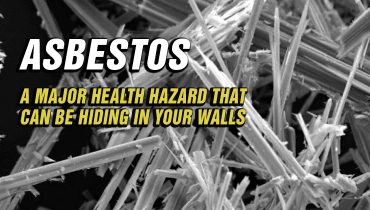Properly working gutters are essential for protecting your home from water intrusion — and gutter guards add a valuable layer of defense. They keep leaves, twigs, and debris out while...

4 Important Features for Deck Safety
By Mike Holmes
Mike’s Advice / Outdoor Renovations
Tuesday, September 1st, 2020 @ 1:00am
A deck’s handrails and guardrails are vital safety features for a deck of any size. The footings and posts are also essential parts of the support structure, which must be correctly built and protected to ensure the safety of the entire deck structure.
Building codes can vary city-to-city, depending on local environmental factors, building conditions, construction practices, restrictions, and limitations. The following is a basic summary of general minimum safety measures when it comes to handrails, guardrails, footings, and posts and what to check for when inspecting decks.
All homeowners are encouraged to contact their local building authority to find out what the building code dictates for these deck parts in their area. Understanding these safety features will prevent deck collapse and injury:
#4. Handrails
The handrail should be able to resist a single concentrated load of about 200 pounds, applied in any direction at any point along the handrails to meet code.
Did you know?
A handrail is NOT required for stairs or a ramp if the following applies:
- the interior stairs have two or fewer risers
- the exterior stairs have no more than three risers
- the ramp rise is less than 15.7 inches
(NOTE: always check with your local building codes)
#3. Guardrails
Guardrails should be able to resist a minimum 200-225 lb load or, in some cases, 34 lbs per foot along its length.
The railing post connection is crucial, but unfortunately, it’s often inadequately constructed. The post must be fastened to the rim joist as well as tied back into the joist framing for proper load resistance.
Machine bolts through the post and rim joist alone do not typically meet performance requirements.
Guardrail Height:
All decks higher than 30 inches above grade must have a guardrail. When required, guardrails should be located along surfaces more than 24 to 30 inches above the floor or grade below, including porches, balconies, raised floor areas, stairways, landings, and open-sided walking surfaces.
Guards should be a minimum of 36 to 42 inches tall for specific occupancies. Some local codes dictate that guardrails should be a minimum of 36 inches tall when the finished floor is less than 70 inches above the finished grade, and 42 inches tall for all other heights above grade.
Guardrail load resistance:
Guardrails should be able to resist a single concentrated load of 200 to 225 lbs or 34 lbs per foot along its length, applied in any direction along the top of the guardrail. For infill elements, such as pickets or solid panels, the individual components must also support a horizontal load of 113 lbs.
DID YOU KNOW?
Guardrails made of pickets should be less than 4″ apart (approximately the width of your fist) and cannot be climbable. In some cases, like ornate wrought-iron barriers, a transparent plastic barrier may be required on both sides and mechanically fastened to meet code.
#2. Footings
What are footings?
A footing is an essential part of foundation construction and helps to ensure your deck is stable and safe. The primary function is to support the foundation and prevent settling. Footings guarantee that the deck will not fall, tip, or rot. Large decks that are attached to the house should always have footing as they help carry the load of the deck and ensure adequate weight distribution to support the structure.
Building codes have specific requirements when it comes to footing size. These requirements depend on different factors, such as the dead and live loads of the deck and soil conditions.
How Deep Should Footings Be?
Footings should be at least 12 inches below the undisturbed ground surface. The footing depth depends on the type of subsurface you are bearing on, and is typical should be below the frost line, which changes depending on location.
In some cases, larger footings are necessary to meet specific load requirements. Concrete patios and pre-cast concrete piers do not qualify as proper footings for deck construction.
What Are Helical Piles
When it comes to deck safety, the importance of solid footing cannot be emphasized. And that’s where helical piles come in.
Why do I recommend helical piles for footings? For starters, they can adapt to many soil types such as sandy, rocky, and even clay. The helical piles are screwed into the ground until they reach the required depth and torque, ensuring a sturdy foundation that can support your deck with ease. So, no matter what sort of soil you have, helical piles can handle it.

Helical piles are big green screws that are screwed into the ground until they reach the required depth and torque, ensuring a sturdy foundation that can support your deck with ease.
They’re also made of strong steel that can survive the test of time and the elements. Bring it on, wind, rain, and snow! This will give you peace of mind knowing that your deck is firmly anchored and can handle any load.
#1. Posts
A deck’s posts should be designed and anchored to resist uplift and lateral movement. For posts to adequately resist various types of loads, they must be supported by and anchored to concrete footings.
In some cases, deck posts and columns must be made from pressure-treated or preservative-treated wood to resist decay or elevated off the concrete footing by at least one inch (or both) to adequately protect against precipitation and moisture.
RELATED
Learn more about Wood Decks and Fire Safety.
A one-inch standoff at the base of the post is required when building with wood that is not preservative or decay-resistant. The standoff plate raises the post end off the concrete, keeping it drier and reducing the chances of decay.
Important Tip: For best long-term results, a base with a standoff is recommended for all exterior/wet applications. It might not always be a minimum requirement, but it is still good practice.
Post and Column load resistance:
Posts and columns must be restrained to prevent lateral displacement at the bottom end. Wood columns should be a minimum of 4 X 4 inches in size, but I always recommend no less than 6 inches by 6 inches unless calculations can show otherwise. Column and post-end connections should also be fastened or anchored to resist lateral movement and uplift forces.
Wood Post and Column Decay resistance:
Wood posts and columns should be made from naturally decay-resistant wood or pressure or preservative-treated wood. If the posts and columns are exposed to precipitation, or if the clearance between the end of the post and the finished ground level is less than 6 inches, pressure or preservative-treated wood may be recommended.
In some cases, posts and columns exposed to weather do not necessarily need pressure or preservative-treated wood. Concrete piers that support posts, or metal pedestals projecting at least one inch above a concrete floor, or a minimum of 6 inches above exposed earth; the earth must be covered by an approved impervious moisture barrier.
RELATED
Great Backyard & Patio Ideas and link to the YouTube Ultimate Deck Renos.










